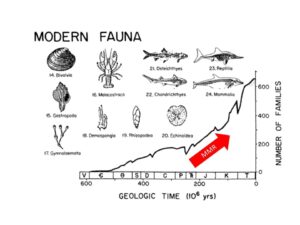A predator-prey arms race in Mesozoic oceans
Background
The diversity of modern marine animals has increased dramatically over the past 230 million years, beginning with an event called the Mesozoic Marine Revolution (MMR). Over this period, marine fauna has gradually developed from sessile, epifaunal benthic assemblages in the Palaeozoic and early Mesozoic to more motile and structured/tiered communities we see today through the Late Triassic, Jurassic and Cretaceous.
Is there evidence of changes in trophic structure and trait evolution that indicate evolutionary escalation in Mesozoic oceans?
The escalation hypothesis was proposed by Vermeij (2008) and refers to an evolutionary pattern captured by measurement of a physiological response to predation pressure. The escalation hypothesis is a fundamental Red Queen (van Valen 1973) pattern and characterises predator-prey arms races.

The core hypothesis about this radiation, and particularly the transition to a tiered community, is that of a predator – prey arms race. The hypothesis suggests that newly evolved and diversified predators (i.e. durophagous fish, malacostracan crustaceans, extraoral asteroids, drilling gastropods etc.) stimulated the evolutionary response of benthic marine organisms to develop flight (i.e. increased motility and/or infaunality) and defence (i.e. spikier and thicker shells) mechanisms to avoid being predated.
Hypothesis testing
The student will build a number of ecological datasets from well preserved fossil assemblages from the Late Triassic to Late Cretaceous. Trophic interactions between fossil species will be deduced via a variety of modelling frameworks based on ecological trait data, optimal foraging theory and population growth rates (Shaw et al. 2023; Beckerman et al. 2006; Curtsdotter et al. 2011). The student will test the following hypotheses relating to escalation at the MMR:
- Marine ecosystems increased in trophic complexity throughout the Mesozoic in response to increased predation pressure and prey responses (i.e. escalation).
- Increased predation led to increased trait evolution in prey species (i.e. increased motility and increased levels of infaunal tiering within ecosystems).
- Red Queen processes drove the evolution and diversification of the modern oceanic biota during the Mesozoic.
Impact and publications
This project will pioneer the use of well-developed ecological modelling techniques to address a long standing controversy in the evolution of life in the oceans – did Red Queen processes drive the evolution of the modern oceanic biota during the Mesozoic? The work is divisible into publications that form consecutive chapters of the PhD thesis.
An excellent training and research environment: This interdisciplinary project will provide the successful PhD candidate with highly valued and sought-after tools for investigating macroecological and macroevolutionary processes. The student will gain experience and expertise in database construction, fossil specimen taxonomy, trait quantification, and ecological modelling, and macroevolutionary modelling. This will equip the student with the necessary expertise to become the next generation of palaeontological and ecological scientist, ready to carry out their own programme of innovative scientific research. The student will be based within the nurturing and supportive environment of the Dunhill lab where student development and wellbeing comes before all else and will benefit from working within and collaborating with dynamic scientists within the CASCaDE team, the multidisciplinary Palaeo@Leeds research group as well as the quantitative evolutionary ecology group at Sheffield. There will be opportunities to present results at major, international conferences, e.g. BES, GSA, PalAss, and attend residential summer-schools (e.g. in USA, UK) and in-house workshops and courses.
Student profile: A good first degree (1 or high 2i), or a good Master’s degree in physical or biological sciences or mathematics with a focus towards ecology, palaeobiology, or evolutionary biology, experience in programming (e.g. R) is an advantage but not essential.
References
BECKERMAN, A. P., PETCHEY, O. L. and WARREN, P. H. 2006. Foraging biology predicts food web complexity. Proceedings of the National Academy of Sciences, 103, 13745-13749.
CURTSDOTTER, A. BINZER, A., BROSE, U., DE CASTRO, F., EBENMAN, B., EKLÖF, A., RIEDE, J.O., THIERRY, A. & RALL, B.C. (2011) Robustness to secondary extinctions: Comparing trait-based sequential deletions in static and dynamic food webs. Basic and Applied Ecology, 12, 571-580.
SEPKOSKI, J. J. 1984. A kinetic model of Phanerozoic taxonomic diversity. III. Post-Palaeozoic families and mass extinctions. Paleobiology, 10, 246-267.
SHAW, J.O, DUNHILL, A.M., BECKERMAN, A., DUNNE, J.A. & HULL, P.M. (2023) Constructing and comparing ancient food webs using functional diversity data. Methods in Ecology and Evolution, in revision
VAN VALEN, L.M. 1973. A new evolutionary law. Evolution Theory, 1: 1-30.
VERMEIJ, G. J. 2008. Escalation and its role in Jurassic biotic history. Palaeogeography, Palaeoclimatology, Palaeoecology, 263, 3-8.
